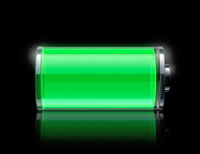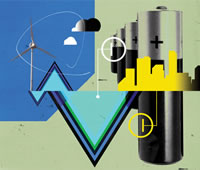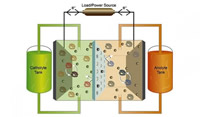Vanadium Redox Flow Batteries
Storion has focused on securing access to a unique vanadium leasing model. Because the vanadium electrolyte represents 40-60% of a VRFB system's cost, it is a clear, leading candidate for cost reduction.
Using Carbon Additives to Improve Performance of AGM Batteries
Batteries that operate in partial state of charge (PSOC) environments can suffer from reduced charge acceptance that can lead to progressive capacity loss.
Going With the Flow on Long-Duration Energy Storage
An ideal long-duration storage technology is one that is cheap, safe and lasts a "utility lifetime" (20+ years) without degradation. In that regard, flow batteries represent a commercially viable solution.
Are Sulfur Flow Batteries the Answer?
In a flow battery, both the anode and cathode are liquid electrolytes. The anode in this case is sulfur dissolved in water, while the cathode is an aerated liquid salt solution that takes up and releases oxygen.
Scientists invented a battery that could work for a decade without degrading
Mike Wehner for BGR: Energy storage degradation in rechargeable batteries is a pretty serious problem that many of us put up with on a regular basis. It’s why your iPhone seems to last forever when it’s brand new out of the box but seems like it dies by lunchtime after a couple of years of use. Now, researchers at Harvard have developed a new battery technology using a bit of chemistry magic to create a rechargeable power source that could be tapped for many years with very little in the way of maintenance.
Energy storage degradation in rechargeable batteries is a pretty serious problem that many of us put up with on a regular basis. It’s why your iPhone seems to last forever when it’s brand new out of the box but seems like it dies by lunchtime after a couple of years of use. Now, researchers at Harvard have developed a new battery technology using a bit of chemistry magic to create a rechargeable power source that could be tapped for many years with very little in the way of maintenance. Cont'd...
Batteries Need to Get Big-Like, Enormous-for Solar Power to Shine
Vaclav Smil for IEEE Spectrum: It would be a lot easier to expand our use of solar and wind energy if we had better ways to store the large quantities of electricity we’d need to cover gaps in the flow of that energy.
Even in sunny Los Angeles, a typical house roofed with enough photovoltaic panels to meet its average needs would still face daily shortfalls of up to about 80 percent of the demand in January and daily surpluses of up to 65 percent in May. You can take such a house off the grid only by installing a voluminous and expensive assembly of lithium-ion batteries. But even a small national grid—one handling 10 to 30 gigawatts—could rely entirely on intermittent sources only if it had gigawatt-scale storage capable of working for many hours.
Since 2007, more than half of humanity has lived in urban areas, and by 2050 more than 6.3 billion people will live [PDF] in cities, accounting for two-thirds of the global population, with a rising share in megacities of more than 10 million people. Cont'd...
DOE energy innovation hub backs two key future battery technologies
Nick Flaherty for EE Times: After four years of evaluation, the Joint Center for Energy Storage Research (Chicago, IL) is backing two key technologies for the future of battery systems.
The Center was set up four years ago with a five year remit to explore new battery technology for transportation and the electricity grid that, when scaled to commercial production, are capable of delivering five times the energy density at one-fifth the cost of commercial batteries available in 2011.
The Center has investigated 1,500 compounds for electrodes and 21,000 organic molecules relevant for liquid electrolytes as well as filing 52 invention disclosures and 27 patent applications, says director George Crabtree. Five techno-economic models created by JCESR for designing virtual batteries on the computer are being used to evaluate the best pathways for beyond-lithium-ion systems to reach 400 watt hours per kilogram (400 Wh/kg) and $100 per kilowatt hour ($100/kWh). Cont'd...
Flow Batteries in Cars?
Flow battery technology is immature. There is everything to play for and although pumping liquids from reservoirs does not sound compact or reliable in a car but who knows? Watch this space.
Is 2016 The Turning Point For Energy Storage?
Michael McDonald for OilPrice.com: In the future, when investors look back at the year that represented the turning point for clean energy, 2016 may be it. The industry overall is growing at a breath-taking pace, but perhaps not for the reason that some investors think. Energy storage rather than solar power and wind power are the real factors that are driving a revolution across the electrical power industry.
Energy storage changes the equation, not only in the renewables space, but in the conventional utility space as well. The concepts of spin/non-spin reserve costs, peaker prices, and a variety of other conventional concerns for utilities, lose meaning in the context of efficient and cost-effective energy storage. While energy storage was available previously, it’s only today that costs are coming down substantially. Tesla’s economies of scale on battery storage are well-known, but small start-ups like Orison are finding ways to lower costs in innovative ways as well. The graphic below from a recent EPRI presentation highlights the role that multiple layers of costs savings can play in creating economical battery storage. Cont'd...
The "Redox" Principle
The energy density of the nanoFlowcell® is currently 20 times higher than that of a lead accumulator. This means the stored energy provides a range 20 times higher than with a battery of the same weight.
ViZn Energy Systems' 2MW Zinc-Iron Redox Flow Battery System Selected by Hecate Energy for Ontario IESO Project
System to be largest commissioned flow battery installation in North America and Europe
Vanadium Flow Batteries for Global Academy of Technology (GAT) College
By implementing the IMERGY storage solution in the premises, GAT is able to store the energy produced by the PV panels during the day and use it during the non-solar time, thus eliminating the diesel generator run to provide clean power when needed.
UniEnergy Technologies Announces Commissioning of Largest Capacity Flow Battery in North America and Europe
The largest capacity flow battery operating in North America and Europe.
Records 1 to 13 of 13
Featured Product

EVERVOLT home battery storage: Dependable power, with or without solar
Whether paired with solar or used independently, the renewable energy stored in an EVERVOLT home battery system serves as a reliable backup against unpredictable utility grid fluctuations and weather-related events. Keep essential appliances running longer and maintain your lifestyle during unforeseen circumstances. Our EVERVOLT battery storage systems are backed by a comprehensive 12-year warranty from Panasonic, including coverage for labor. Learn More about Panasonic EVERVOLT.











